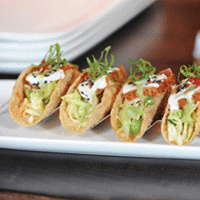No segment was safe in the economic storm, but midmarket restos are finally seeing diners return
Everyone has weighed in on the fiscal implosion of 2009. The event was a treacherous game changer that levied numerous challenges for foodservice operators, and although fine dining might have experienced a more dramatic drop in customer count, no segment was left unscathed. Now, nearly two years out from The Great Recession, operators are optimistic that steady progress bodes well for the future, but none are willing to rest on their laurels. If the game has changed, most midmarket operators are excited to change with it.
“We’ve had continuing growth through all four quarters last year, with East Side Mario’s showing positive growth,” says Grant Cobb, senior vice-president, brand management, at Prime Restaurants. “It’s been tougher for the pubs and Bier Markt.”
The Burlington, Ont.-based Prime Restaurants operates well-known casual brands such as East Side Mario’s, Casey’s, Prime Pubs (Fionn MacCool’s, D’Arcy McGee’s, Paddy Flaherty’s) and two Bier Markt locations. The company has seen modest improvement at its restaurants, with East Side’s sales growth up from 0.81 per cent in Q1 of 2010 to 5.43 per cent in Q4.
While the casual Italian chain has continued to show encouraging growth in the first quarter of this year, Cobb cites poor weather as a major cause of slowness in the pub sector. “Last year, March had 15 or 16 patio days. This year, we had one or two at most.”
Cobb, however, is candid about the challenges the industry faced, and the hustling some operators had to do to convince cash-strapped patrons to give dining out a chance. “Our industry took it on the chin in 2009. It was a perfect storm, and since then we’ve had a tremendous amount of competition.”
As for 2010, Cobb says the storm was quieter and the battlefield scarce, making incremental improvements possible. “The economy stabilized a bit, and we’ve seen fewer openings. Consumer confidence is also up. This year, we’ve been pleasantly surprised by the results. Customer count is improving, but we’re still worried about high gas prices and how they might cut into consumer’s disposable income.”
Like other restaurants in the midmarket segment, the eateries under the Prime umbrella suffered belt-tightening and engaged in what Cobb called “wheeling and dealing.” To cope with the downturn, the company reduced development projects and sought to make internal improvements, such as enhancing service, aesthetics and incentives.
“No one wants to play the discount game, but things have changed, and value offerings are more common,” admits Cobb. So, when the coffers start to dwindle, some operators agree — albeit reluctantly — to tango with the coupon crowd. For Casey’s and East Side’s, promos became de rigueur. “The wheeling and dealing carried on through 2010, and it’s still prevalent, so we’re still in that game. We hope to eventually wean ourselves off.”
Despite the reluctance to tempt a $10 coupon in front of penny-pinching diners, Cobb does agree the tactic drove traffic, and says promoting the value in dining at restos offering all-you-can-eat specials bodes well for the company from a marketing standpoint. And while deals are a crowd pleaser and competitive price points are a plus, Cobb says Prime restos benefit from customer loyalty as well. “In Ontario especially, the majority of players are restaurants people grew up with.”
Needless to say, one of the best incentives remains a fresh menu and look, a trend Cobb says the brand embraced. “We refresh the menus at 12 to 14 month intervals, and we always ensure that the guest leaves satisfied. That’s job number 1. Regardless of promos or media exposure, if the guest isn’t satisfied, the restaurant can’t win.” For other midmarket brands, the story is similar, albeit with diverging plot points surrounding diner incentives. For Joey Restaurants, a company that runs 19 eponymous restos across Canada and Washington State, culinary enhancement remained a key priority, while development was pursued and discount incentives avoided.
“We’re finding sales are growing,” says Chris Mills, vice-president of Culinary Development and executive chef for the company. “We’ve grown over the last two years by investing in the stores we have, and we’ve even opened two new locations, one in Toronto and another in Burnaby, B.C. We want to grow organically.”
Though Mills didn’t offer exact numbers, he attributes the brand’s steady growth to a strong foundation and good service model. “Some restaurants might reduce quality or offer discounts [during a downtown],” says Mills. “We wanted to just keep adding value. We don’t think cutting corners or discounting are good long-term strategies.”
To cope with the rough patch, Joey reinvigorated its appeal, focusing on revamping food and service. “I took some chefs to the James Beard House and put managers through service and media training. A professional consultant taught them how to make service more about hospitality than technicalities.”
Other brands agree that discounting should be approached with caution. Perry Schwartz, director of Communications at Boston Pizza, says mindfulness is crucial. “We have been disciplined with respect to providing guests value with great food and service and limiting price promotions,” he says. “Our focus has been on staying true to our core value proposition without discounting. The group-buying trend is certainly something we’re seeing in the industry but not necessarily something we would heavily participate in.”
For the Richmond, B.C.-based chain, its numbers reflect industry trends. Schwartz said the brand experienced gross sales of $853 million in 2010 (up from $848 million in 2009) but saw negative 1.3percent same-store growth. To adapt, the chain, like others, focused on food and atmosphere.“We’ll continue to bring new food, like our new chicken wings, to market,” says Schwartz. “We’re always listening to our guests and testing new flavours and menu items. We’re about great food at a fair and reasonable price in a setting where everyone is welcome.”
One thing unique about the segment is the versatility factor. While not quite as thrifty as QSR, midmarket restaurants offer a comfortable — and popular — in between. It’s casual to upscale sit-down dining, perfect for a relaxing night out or business lunch. With a heavily saturated market, carving out a niche can be difficult, therefore operators tend to focus on value offerings, especially when dealing with recession-weary guests. It doesn’t hurt that the market doesn’t require diners to break the bank (generally speaking) to begin with.
“My thoughts are, it [midmarket price points] probably helped,” agrees Joey’s Mills. “Everywhere, even in New York City, expense account-type restaurants were hurt the most. A lot of places are going more casual. There’s value in the combination of price point and quality.”
While Cobb says loyalty and recognition play a part in the market’s success, Mills says that, for him and Joey, upping the ante works, too.
“We keep working harder and training people better,” he says. “As we improve, we provide more of an experience from the food, beverage, service and environment stand point. All at less cost. Our customers are excited about the segment.”
Mills also stresses the importance of happy employees who don’t see foodservice work as a transitional or last-resort occupation but an opportunity to grow and thrive in an exciting industry. “We want great cooks who advocate for the brand. If you look at the old-school thought that you should hire cheap and offer little, you realize it didn’t work. The best long-term approach is to create brand mavens.”
On the food side, Cobb and Mills, like Schwartz, agree that keeping on top of cusine is crucial. “You want to improve both service and food quality,” says Cobb. “Local is a big trend, and low-sodium options are more popular. People also like calorie counts on menu items and bolder flavours. Like anything else, you need to make the product relevant to the guest.”





















